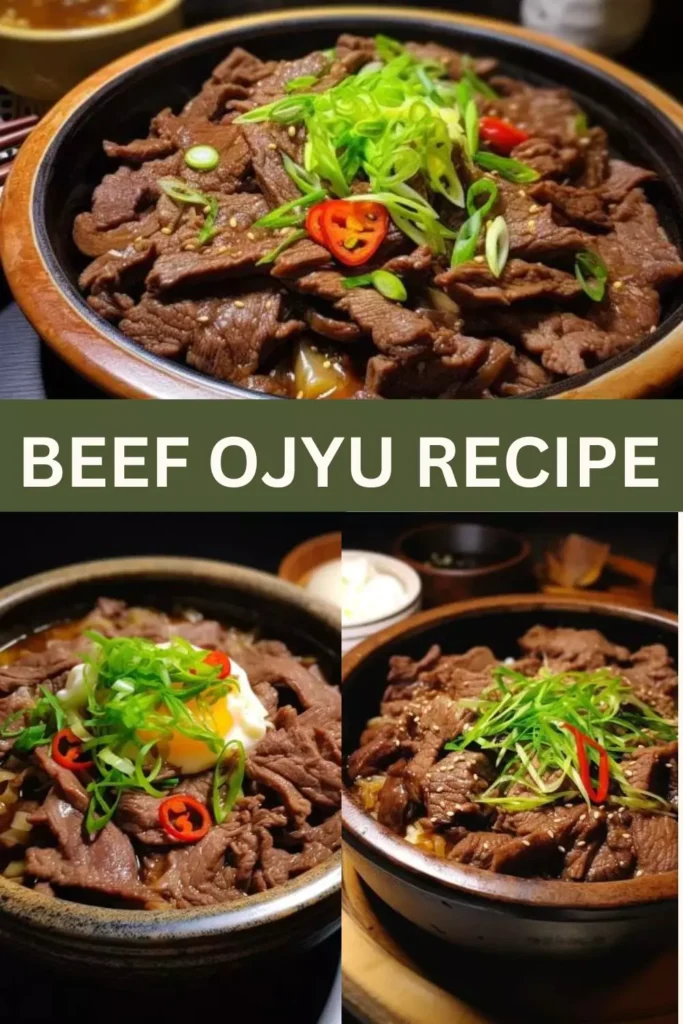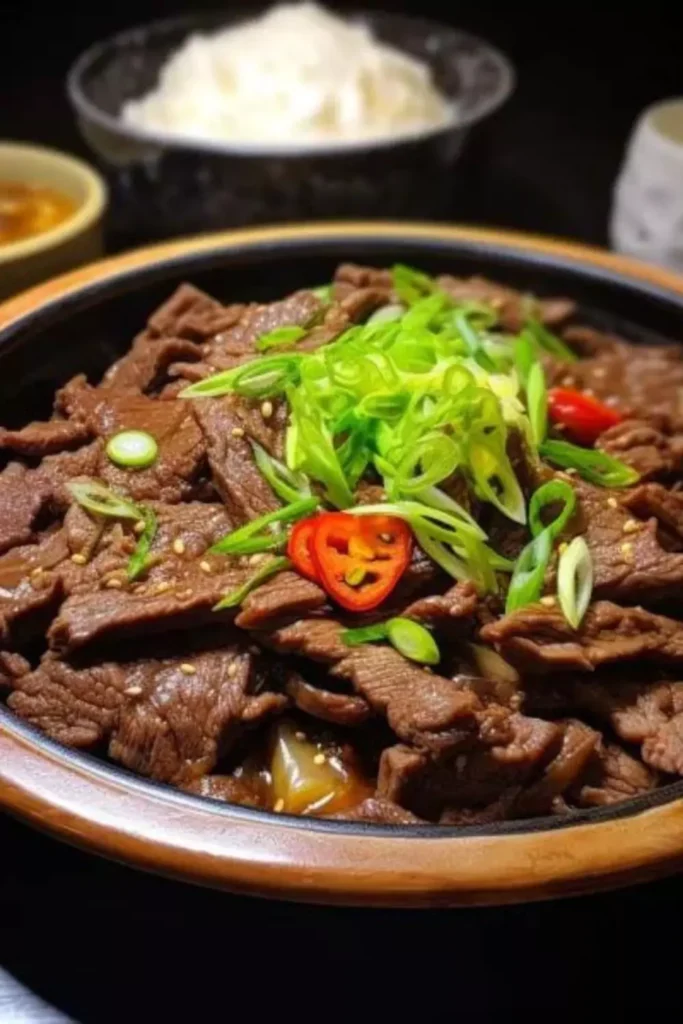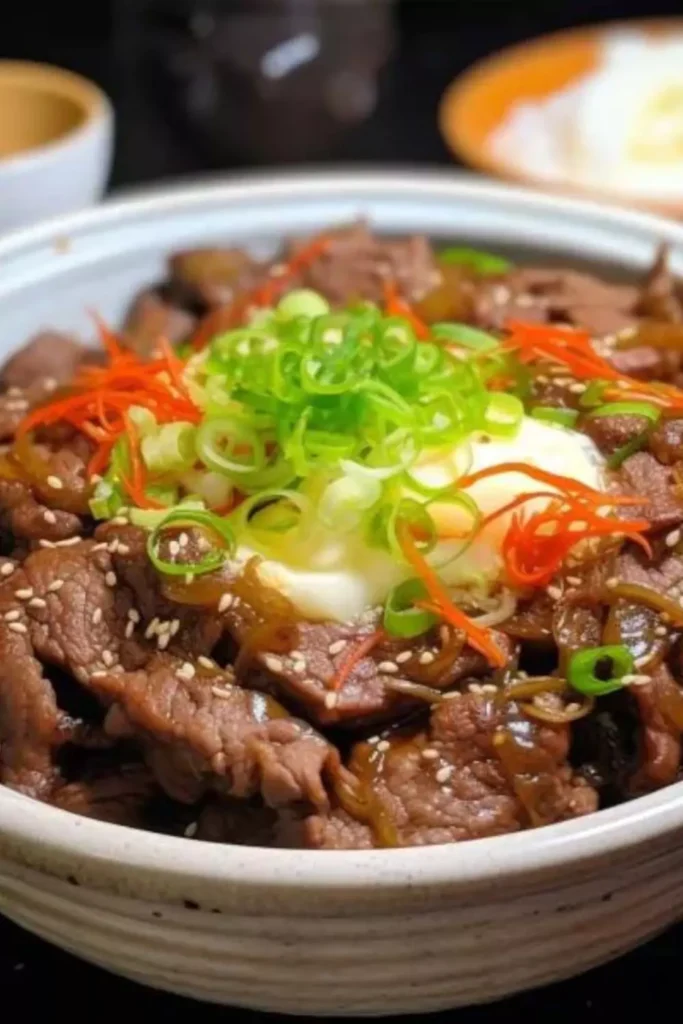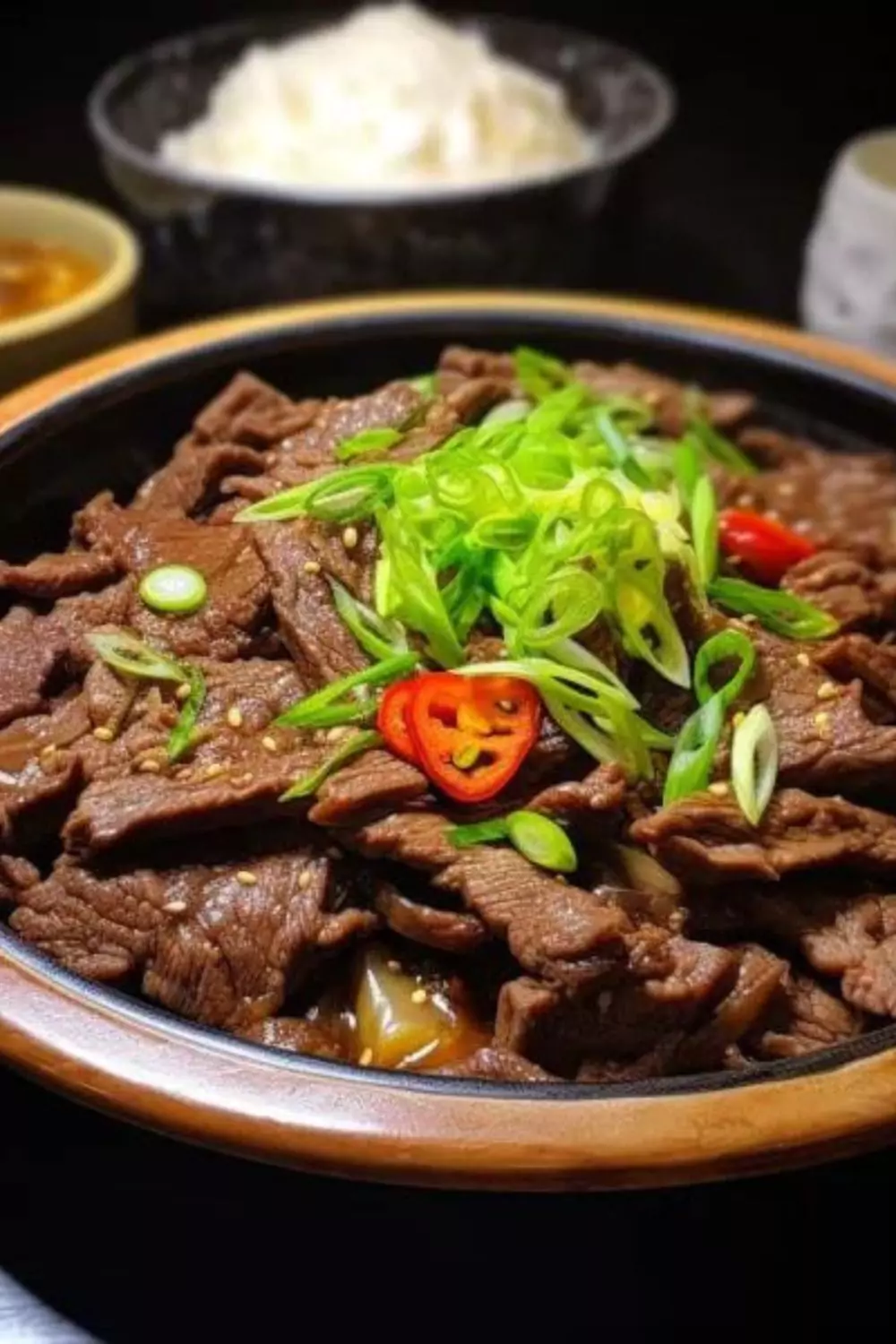Beef Ojyu is a traditional Japanese dish that is typically served as a side dish or appetizer. It is made with beef, vegetables, and other ingredients, and is usually served with a ponzu sauce. It is a simple yet flavorful dish that is sure to be a hit with your family and friends.
In this blog post, we will take a look at the ingredients and step by step instructions for making this delicious dish, as well as some tips and variations to make it even more tasty. We will also cover the nutrition information and how to store it for later use. So let’s get started!

What is Beef Ojyu?
Beef Ojyu is a Japanese dish traditionally served as an appetizer or side dish. It is made with thinly sliced beef, vegetables, and other ingredients, and is usually served with a ponzu sauce.
The beef is cooked in a mixture of soy sauce, sake, and mirin, and the vegetables are cooked in a mixture of oil, soy sauce, and sugar.
The combination of the beef and vegetables creates a savory and flavorful dish that is sure to be a hit with your guests.
Why You’ll Love this Beef Ojyu?
Beef Ojyu is a delicious dish that is full of flavor and can be made in just a few minutes. The beef is cooked in a mixture of soy sauce, sake, and mirin, and the vegetables are cooked in a mixture of oil, soy sauce, and sugar.
This creates an incredibly flavorful dish that is sure to please your guests. It is also a great way to use up leftovers and can be easily adapted to whatever vegetables you have on hand.
You will also like the following Appetizer recipes!
- Copycat Joanna Gaines Chicken Spaghetti Recipe
- How to make Pappadeaux Crab And Spinach Dip
- Easy Costco Pinwheels Recipe
The Ingredients
Sirloin or rib eye beef: This is the main ingredient for the dish and should be thinly sliced to ensure tenderness and succulence.
Dashi: This Japanese soup stock adds a complex and savory base to the dish. It can be made from scratch using kelp, bonito flakes, or convenient dashi powder can be used.
Onions: Thinly sliced onions are added for a caramelized and sweet flavor profile.
They cook down and blend well with the other ingredients, adding a little texture and sweetness to the dish.
Eggs: The eggs provide a luscious and creamy finish to the dish. They are typically added on top of the beef before serving and can be cooked sunny-side up or scrambled.
Mirin: This sweet rice wine adds a subtle sweetness and depth of flavor to the dish. If unavailable, it can be substituted with a mixture of sugar and vinegar.
Sake: This Japanese rice wine adds a mild and aromatic essence to the dish. It can also be replaced with dry sherry or Chinese Shaoxing wine.
Soy Sauce: Soy sauce is used for its savory and umami-rich taste. It balances out the sweetness from the mirin and adds depth of flavor to the dish.
Japanese Rice: Cooked Japanese rice is used as a base for the beef and vegetables. It provides a fluffy and slightly sticky texture that complements the other ingredients well.
Green Onions: Thinly sliced green onions are used as a garnish for a fresh and mildly pungent flavor. They add color and freshness to the dish.
Sugar: Sugar is used to balance out the flavors and impart a hint of sweetness. It can be adjusted to taste depending on personal preference.
Vegetable Oil: This is used for cooking and enhances the flavors of the other ingredients. It also ensures a delightful mouthfeel in each bite.

Step by Step Instructions
Step 1: Heating a large skillet:
Heat a large skillet over medium heat and add vegetable oil.
Step 2: Cooking the beef:
Add the thinly sliced beef to the skillet, cooking for 2-3 minutes until it starts to brown. Once cooked, transfer the beef to a separate plate and cover with aluminum foil to keep warm.
Step 3: Cooking the onions:
In the same skillet, add onions and cook until they are soft and browned, about 5 minutes.
Step 4: Cooking the eggs:
Cook the eggs sunny-side up or scramble them in a separate pan and set aside.
Step 5: Preparing the ojyu sauce:
In a small bowl, mix together soy sauce, mirin, sake, and sugar to create the ojyu sauce.
Step 6: Combining ingredients:
Return the cooked beef to the skillet with onions and pour in the ojyu sauce. Cook for 1-2 minutes to let the flavors combine.
Step 7: Serving:
Serve the beef and onions over a bed of cooked Japanese rice. Top each plate with a cooked egg and garnish with thinly sliced green onions.
Step 8: Enjoy:
Serve immediately and enjoy your delicious Beef Ojyu!
Notes
Here are a few tips and tricks to help you make the perfect beef ojyu:
– Make sure to slice the beef as thinly as possible for the best texture and flavor.
– Use a good quality soy sauce for the best flavor.
– Mirin is sweet, so adjust the amount to suit your tastes.
– If you can’t find ponzu sauce, you can use a mixture of soy sauce and lemon juice.
– You can also use other vegetables in this dish, such as bell peppers, bok choy, or cabbage.
– For a spicier version, add a pinch of red pepper flakes to the beef mixture.
– You can serve the beef ojyu with rice or noodles for a more filling meal.

Nutrition Information
This beef ojyu recipe is a healthy and nutritious dish that is low in fat and calories. It is also an excellent source of protein and vitamins A and C. One serving contains approximately:

How to Store Beef Ojyu?
Leftover beef ojyu can be stored in an airtight container in the refrigerator for up to three days.
Reheat in the microwave or on the stovetop until heated through.
Variations
Vegetarian: To make a vegetarian version of beef ojyu, replace the beef with tofu or tempeh.
Spicy: To add some heat to the dish, add a pinch of red pepper flakes to the beef mixture.
Curry: To give the dish an Indian twist, add a tablespoon of curry powder to the beef mixture.
Noodles: For a more filling meal, serve the beef ojyu over a bed of noodles.
Fried Rice: Serve the beef ojyu over a bed of fried rice for an easy and delicious one-pot meal.
Soba Noodles: For a lighter version, serve the beef ojyu over a bed of soba noodles.

Equipment
- large skillet
- pan
Ingredients
- 1 lb. thinly sliced sirloin or rib eye beef ensuring tenderness and succulence
- 1 cup dashi Japanese soup stock for a complex and savory base
- 2 large onions thinly sliced for a caramelized and sweet flavor profile
- 4 eggs for a luscious and creamy finish
- 6 tbsp. mirin sweet rice wine to add a subtle sweetness and depth of flavor
- 4 tbsp. sake Japanese rice wine for a mild and aromatic essence
- 6 tbsp. soy sauce for a savory and umami-rich taste
- 4 cups cooked Japanese rice providing a fluffy and slightly sticky texture
- 4 green onions thinly sliced for a fresh and mildly pungent garnish
- 4 tbsp. sugar to balance the flavors and impart a hint of sweetness
- 2 tsp. vegetable oil to enhance the cooking process and ensure a delightful mouthfeel
Instructions
- Begin by heating a large skillet over medium heat and adding vegetable oil.
- Add the thinly sliced beef to the skillet, cooking for 2-3 minutes until it starts to brown.
- Once the beef is cooked, transfer it to a separate plate and cover with aluminum foil to keep warm.
- In the same skillet, add onions and cook until they are soft and browned, about 5 minutes.
- In a separate pan, cook the eggs sunny-side up or scramble them and set aside.
- In a small bowl, mix together soy sauce, mirin, sake, and sugar to create the ojyu sauce.
- Return the cooked beef to the skillet with onions and pour in the ojyu sauce. Cook for 1-2 minutes to let the flavors combine.
- Serve the beef and onions over a bed of cooked Japanese rice.
- Top each plate with a cooked egg and garnish with thinly sliced green onions.
- Serve immediately and enjoy!
Notes
Nutrition
Frequently Asked Questions
What type of beef is used for beef ojyu?
Thinly sliced sirloin, flank, or skirt steak are typically used for beef ojyu.
Is beef ojyu spicy?
It can be, depending on the amount of red pepper flakes that are added to the beef mixture.
How long can beef ojyu be stored in the refrigerator?
Beef ojyu can be stored in an airtight container in the refrigerator for up to three days.
Is beef ojyu a healthy dish?
Yes, beef ojyu is a healthy and nutritious dish that is low in fat and calories. It is also an excellent source of protein and vitamins A and C.
Is beef ojyu served hot or cold?
Beef ojyu is usually served hot.
Conclusion
Beef ojyu is a traditional Japanese dish that is full of flavor and easy to make in just a few minutes. It is made with thinly sliced beef, vegetables, and other ingredients, and is usually served with a ponzu sauce.
It is a delicious dish that is sure to be a hit with your family and friends. Try it today and see for yourself!
